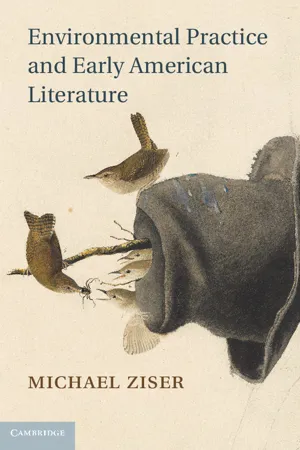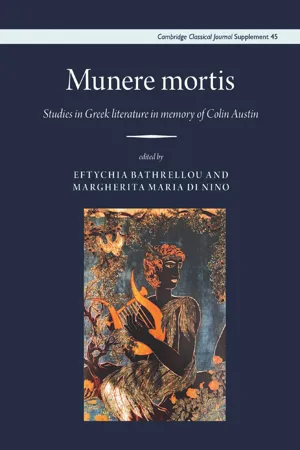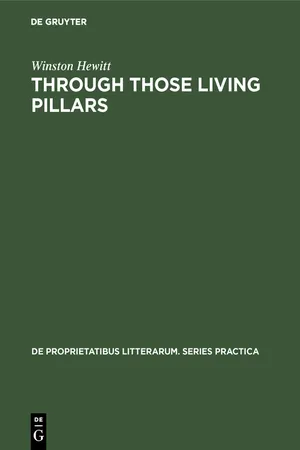Literature
Pathetic Fallacy
Pathetic fallacy is a literary device where human emotions are attributed to nature or inanimate objects. It is used to create a mood or atmosphere in a literary work. For example, a stormy sky may be used to reflect the turmoil in a character's mind.
Written by Perlego with AI-assistance
Related key terms
1 of 5
5 Key excerpts on "Pathetic Fallacy"
- Michael Ziser(Author)
- 2013(Publication Date)
- Cambridge University Press(Publisher)
The Pathetic Fallacy in phrase and concept appealed to my desire to gain some conceptual leverage over the texts I was reading, and the derogatory secondary mean- ing of “pathetic” simply made the tropes of personification and anthropo- morphism seem all the more self-evidently unworthy of serious attention. To Thoreau’s conceit about the corn “writing” I might well have said, smugly: “pathetic indeed.” With time, experience, and subtler teachers, I eventually modified my understanding to better accord with the com- plexity of John Ruskin’s original exploration of the way that the necessary “subjectivism” of art, if not reined in, can issue in absurd forms of proso- popoeia that blur seemingly crucial distinctions between the world as it is Introduction 2 and the world as we perceive it to be. Importantly for Ruskin, what was in some cases a form of falsity could in the right hands become a beau- tiful and profound rhetorical strategy for representing truth at a higher level than the coldly scientistic. “The Pathetic Fallacy is powerful only so far as it is pathetic, feeble so far as it is fallacious, and, therefore, that the dominion of Truth is entire, over this, as over every other natural and just state of the human mind.” 3 Such nuance was often lost in the later nine- teenth and twentieth centuries, as what we might call an “anti-pathetic” reaction to the Romantic investment in the vitalism of the natural world became influential in American criticism and seeped into literary text- books and the practices of modernist writers.- eBook - ePub
Munere mortis
Studies in Greek literature in memory of Colin Austin
- Eftychia Bathrellou, Margherita Maria Di Nino(Authors)
- 2022(Publication Date)
- Cambridge Philological Society(Publisher)
un true. And what is more, if we think over our favourite poetry, we shall find it full of this kind of fallacy, and that we like it all the more for being so. […] Thus, for instance, in Alton Locke, –‘They rowed her in across the rolling foam – The cruel, crawling foam’.The foam is not cruel, neither does it crawl. The state of mind which attributes to it these characters of a living creature is one in which the reason is unhinged by grief. All violent feelings have the same effect. They produce in us a falseness in all our impressions of external things, which I would generally characterize as the ‘Pathetic Fallacy’.9Over time, however, ‘Pathetic Fallacy’ lost its depreciatory meaning, and became a common term in literary criticism, to denote any anthropomorphic depiction of nature.10 The question of whether this ‘poetic form of thought’11 is to be found in archaic literature has been much disputed.12 Be it as it may, the imparting of human traits to nature becomes a recurring trope in bucolic poetry, in which the close connection between singing herdsmen and their livestock and surrounding nature recalls, and in a sense reactivates, the ‘bond of sympathy’13 typical of the early literature. Bucolic poems present their readers with two polarised depictions: nature is mostly joyful and consonant with the herdsmen and their feelings but, on occasion, it shows a marked emotional response to human death and mourning. Although these can be thought of as two different ways of portraying nature, the ‘pleasure/grief’ dichotomy has implications deeper than the suggestion that Pathetic Fallacy could be a reversal of the locus amoenus , and goes to the poetological heart of the imagery, inasmuch as the locus amoenus and Pathetic Fallacy attribute to nature different degrees of participation in human affairs. The former depicts a natural world that is indeed humanised, even though its alleged anthropomorphic attitude merely reveals a general consonance of the natural world with that of herdsmen so that, for instance, the sweetness of their songs is mirrored and accompanied by that of the surrounding landscape and its sounds,14 or the cattle seem to rejoice at the sound of the herdsmen’s song.15 By contrast, when nature is distraught – whether it mourns in its own right or simply shows sympathy toward humans – the pathos is a reaction ‘to a human situation with characteristically human actions and emotions’;16 - eBook - PDF
Through those living pillars
Man and nature in the works of Emile Zola
- Winston Hewitt(Author)
- 2019(Publication Date)
- De Gruyter Mouton(Publisher)
But the reverse is another aspect of Pathetic Fallacy : a nature lofty, impassive, and indifferent to the condition of man. Pathetic Fallacy, used — at times worn through with overuse — by the romantics, was reversed dramatically by Musset and Hugo, Zola's favorite poets in his youth. Vigny had proclaimed the indifference and hostility of nature in La Maison du berger : La nature se rit des souf-frances humaines. But, perhaps, the strongest point of departure for this reversal of technique for Zola comes from a letter that he received from Flaubert, his realist master. In relating his visit to a leper colony in Algeria, Flaubert describes one of the patients, who must have served in part as a model for the blind man in Madame Bovary, painfully dragging himself to a fountain to drink : Sa bouche, dont les lèvres étaient enlevées comme pour une brûlure, laissait voir le fond de son gosier. Il râlait en tendant vers nous ses lambeaux de chairs livides. Et la nature calme tout à 118 Pathetic Fallacy l'entour! 3 The last elliptical sentence, and particularly its exclamation mark, dramatically illustrates how nature displays its apathy. To heighten the horrors of war, Zola frequently employs aPathetic Fallacy. 4 He interjects references to the serenity and beauty in nature when man slaughters man on the battlefield. Été, the second section of Les Quatre journées de Jean Gourdon, describes a battle between the French and the Austrians. The beauty of the summer day and the pure sky contrast tragically with the slaughter on the chalky plain: O la splendide matinée, et quelle plaine stérile pour tuer et mourir! (CN 442) Jean is wounded in the shoulder and struck to the ground. The vast white plain about him étalait sa désolation sous la sérénité ardente du ciel (CN 443). He manages to crawl to the side of his colonel. Each with one good arm helps the other to rise. - eBook - PDF
- Barbara Hardy(Author)
- 2000(Publication Date)
- The Athlone Press(Publisher)
CHAPTER X The Pathetic Image (i) T HE imagery has many functions in George Eliot's novels. Imagery, for instance, provides a continuing source of pathos. Both the content of the image and the method of presentation make a part of the author's special plea for her characters. In the early stories, as we have seen, it is a plea made necessary by her choice of ordinary unexcit-ing human material. The lack of excitement lies in the char-acters rather than the situations, for after Amos Barton, where both characters and events are unsensational, she relies on a fair amount of melodrama and coincidence. But from the beginning to the end of her writing, though with varying emphasis, as we have seen, she draws on a certain kind of human material which is pathetic as distinct from tragic. It may be unattractive, like Amos Barton, or weak, like Caterina, or limited in sensibility and passion, like Hetty: we must learn to accommodate ourselves to the discovery that some of those 'cunningly-fashioned instruments called human souls have only a very limited range of music, and will not vibrate in the least under a touch that fills others with tremulous rapture or quivering agony' (Adam Bede, ch. ix). Such characters, who play a decreasingly conspicuous part as the novels develop, lack complexity, passion, growth—all the equipment which makes the tragic hero rise in some or other way to his tragic occasion. The pathos of such characters lies—to follow her own formula—in pity rather than admira-tion. Since neither their tragic adventure nor their own aware-ness will arouse the interest of tragedy, George Eliot provides a supplementary appeal on behalf of their very inadequacy. The appeal is made in various ways, and imagery is one. It is possible to trace several pathetic images which recur through-out the novels, often in similar contexts, but changing as George Eliot's concept of tragedy—and her style—changes. 201 - eBook - PDF
Tradition and convention
A study of periphrasis in English pastoral poetry from 1557–1715
- Dorothy Schuchman McCoy(Author)
- 2015(Publication Date)
- De Gruyter Mouton(Publisher)
As Douglas Bush says, The mythologizing of nature is not quite the same as the naturalizing Thomas Hobbes, Answer to Sir William Davenants Preface before 'Gondibert'. The English Works..., ed. Sir William Molesworth (London, 1890), IV, 452. PERIPHRASE WITHOUT PURPOSE 203 of mythology, and the latter, which is the healthier instinct, is responsible for much of the most attractive verse of the period 67 Bush is speaking, in part, of the adaptation of classical mythologies to individual localities, viewpoints, and poetic situations, and his comment underlines what should be said about periphrastic treatment of natural processes in this study. When the periphrase is so habitual that it is unconcerned about its own meanings, the automatic or exaggerated activity of nature which Ruskin calls the Pathetic Fallacy is likely to occur. When the attribution of improper responses to nature does occur, nature is mythologized whether the gods are named as the source of these responses or not; in fact the naming of gods may serve to keep an animated nature less mythical in a bad sense, and more a part of the obser-vable play of men's feelings and attitudes upon it. It is perhaps here that the distinction may be most effectively drawn between the familiar terms natural sympathy and Pathetic Fallacy. It is almost impossible to write pastoral verse without falling into Ruskin's fallacy when nature is conceived as having no real relationships to man. In the Elizabethan period, some such sympathies are clearly a part of popular belief. The periphrase of the earlier English pastoral poetry, particularly Spenser's, was most often an outgrowth of the astrological systems outlined for shepherds in such books as the Kalendrier des Bergers. The influences behind the planets were real, and the natures of the gods and goddesses who contributed their attributes to mortals born under a certain relationship of signs were real also, though the beings themselves were not.
Index pages curate the most relevant extracts from our library of academic textbooks. They’ve been created using an in-house natural language model (NLM), each adding context and meaning to key research topics.




